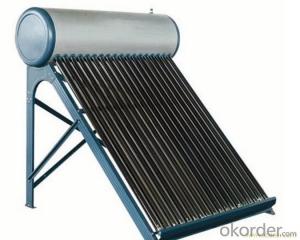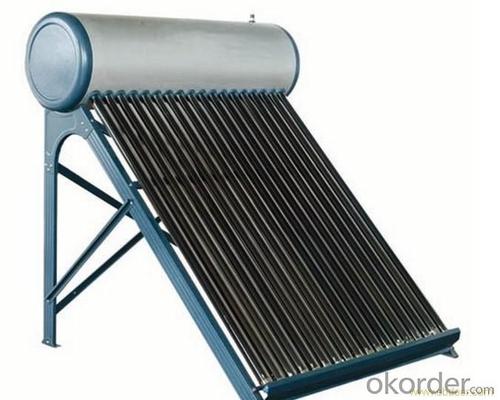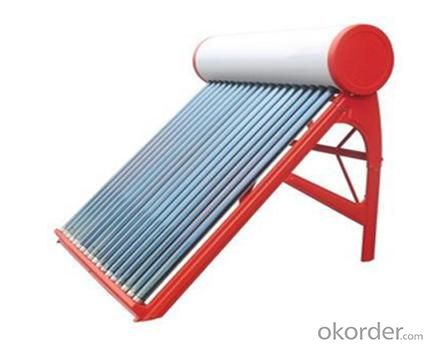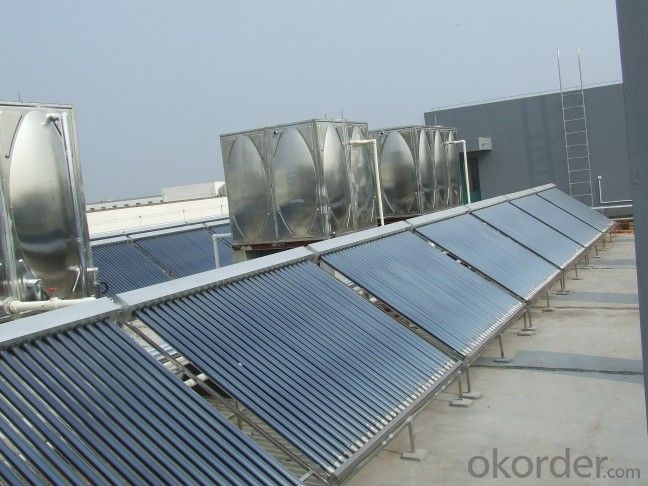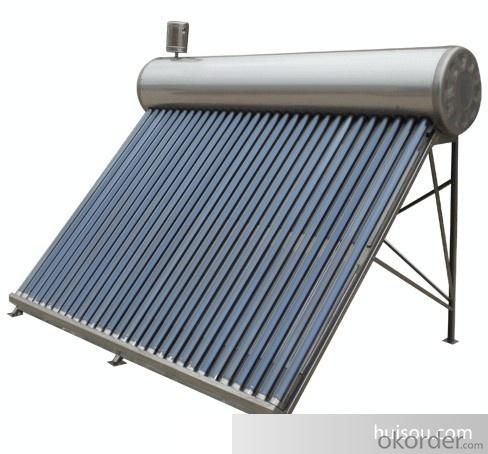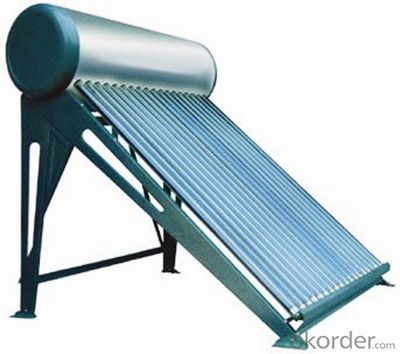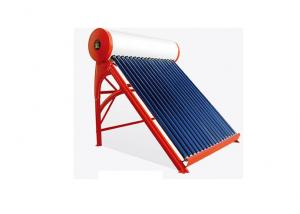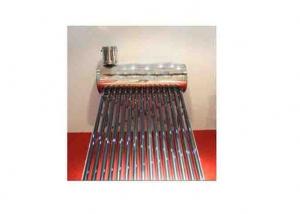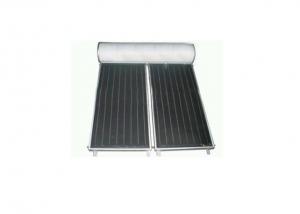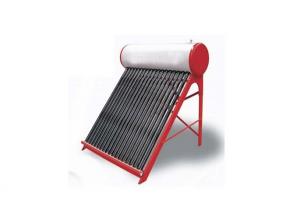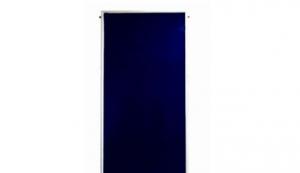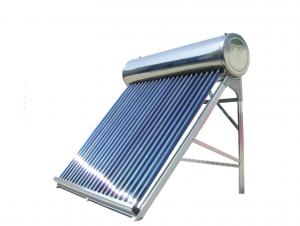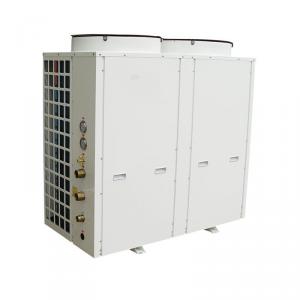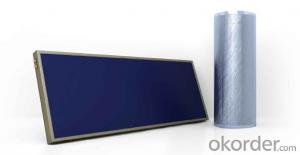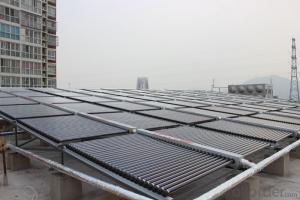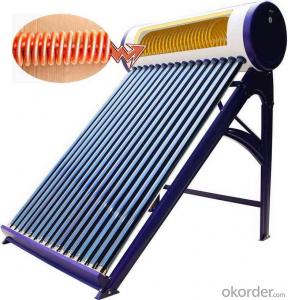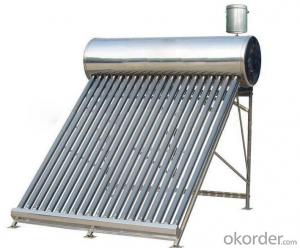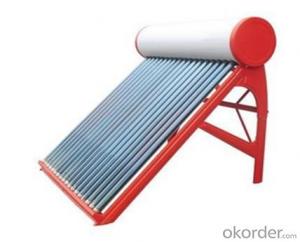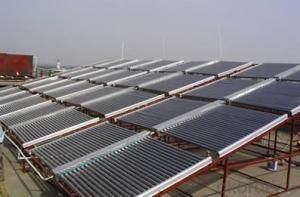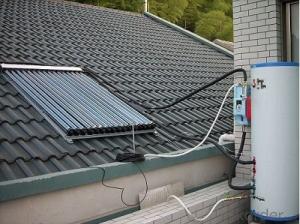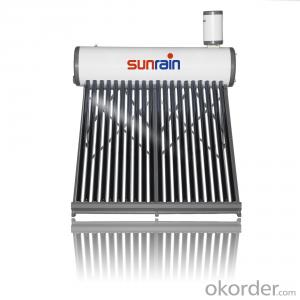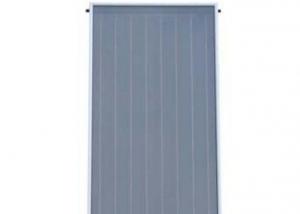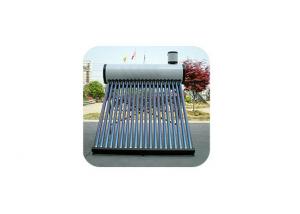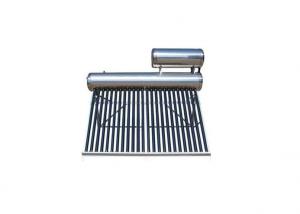Solar Water Heater for Pools with Copper Coil New Design
- Loading Port:
- China main port
- Payment Terms:
- TT OR LC
- Min Order Qty:
- 1 set
- Supply Capability:
- 6000 set/month
OKorder Service Pledge
OKorder Financial Service
You Might Also Like
Introduction of Non-Pressure Solar Water Heater:
Non-pressure Solar Heater is one of the most economical solar water heating device with pretty high efficiency at the same time. It consists of hot water storage tank, solar vacuum tubes with mouth plug in storage tank, and bracket supporting tank and tubes.When cold water in evacuated tubes is heated with solar irradiation, as the specific gravities of hot water and cold water are different, hotter water goes upward to storage tank and colder water goes downward to glass tubes. through this continuous circulation, the cold water in storage tank will be gradually heated till sunset.
Specialty:
1. High thermal performance and working temperature: the heat exchanging rate even in winter can up above 55%.
2. Heat collecting efficiency is at least 20% above common solar systems.
3. Work in all day and all season: no matter any corner of the world, this system can work well even -40℃ to avoid the tube freezing problem.
4. Reliability: No water following through the tube, so water scale can not generate and tube cracks could be avoided, the system still can keep working even with some damaged tubes.
5. It can connect with water tap and work automatically with pressure0.6Mpa, bring enjoyable washing experience.
6. Safety: P/T valve would release pressure and temperature to protect tank..
Technical Specification:
1. Outer tank material: SUS304 stainless steel or powder coated color steel
2. Inner tank material: 1.2mm thick SUS304 food grade stainless steel ( Optional material SUS316L)
3. Vacuum tube material: borosilicate glass 3.3; AL-SS-CU absorb coating, with copper heat pipe inside
4. Frame material: 1.2mm thickness stainless steel
5. Insulation material: 55mm thickness polyurethane
6. Suitable for mains pressure water(up to 8 bar/116psi)
7. Easy plug-in installation
8. Install the T/P valve on the pressurized tank
9. Seal material: Stabilized High Temperature Silicon
Outer tank material: SUS304 stainless steel or powder coated color steel
Inner tank material: 1.2mm thick SUS304 food grade stainless steel ( Optional material SUS316L)
Vacuum tube material: borosilicate glass 3.3; AL-SS-CU absorb coating, with copper heat pipe inside
Frame material: 1.2mm thickness stainless steel
Insulation material: 55mm thickness polyurethane
Suitable for mains pressure water(up to 8 bar/116psi)
Easy plug-in installation
Install the T/P valve on the pressurized tank
Seal material: Stabilized High Temperature Silicon
19. Vacuum Tube | 20. Size (mm) | 21. Φ47*1500 / Φ58*1800 / Φ70*2100 | |||||
22. Tube (pcs) | 23. 10 / 12 / 15 / 18 / 20 / 22 / 24 / 30 / 36 / 42 | ||||||
24. Material | 25. Borosilicate 3.3 glass, magnetron spluttering selective coating | ||||||
26. Coating | 27. Single-target AL-N/AL or Three-target AL/N-Cu-SS | ||||||
28. Water Tank | 29. Capacity | 30. 80L ~ 500L for hot water storage tank | |||||
31. Inner tank | 32. Food-grade stainless steel SUS304-2B / SUS316 | ||||||
33. Insulation | 34. High-density polyurethane foam with 70~80 hour heat preservation | ||||||
35. Tank shell | 36. Food-grade stainless steel SUS304-2B | ||||||
37. Bracket | 38. Shaped strong aluminum alloy structure adaptable for flat or slope roof | ||||||
39. Accessories | 40. Anti-aging silicon seals, Dustproof seals, Air-vent cap, Stainless screws | ||||||
41. Auxiliary Devices | 42. Assistant tank, Intelligent controller, Electrical heater, Magnesium anodes | ||||||
43. Tilt Angle | 44. 25 ~ 50° | ||||||
45. Water Output | 46. 45 - 95°C | ||||||
47. Hail Resistance | 48. Φ25mm diameter | ||||||
49. Model Number | 50. Solar Vacuum Tube | 51. Tank 52. Liter | 53. System 54. Liter | 55. Container Loading Qty /sets | |||
56. Size /mm | 57. Qty /pcs | 58. 20GP | 59. 40GP | 60. 40HQ | |||
61. VNS-58SA12-100 | 62. Φ58*1800 | 63. 12 | 64. 100 | 65. 132 | 66. 58 | 67. 119 | 68. 140 |
69. VNS-58SA15-130 | 70. 15 | 71. 130 | 72. 170 | 73. 54 | 74. 108 | 75. 131 | |
76. VNS-58SA18-150 | 77. 18 | 78. 150 | 79. 198 | 80. 43 | 81. 86 | 82. 105 | |
83. VNS-58SA20-170 | 84. 20 | 85. 170 | 86. 223 | 87. 40 | 88. 80 | 89. 97 | |
VNS-58SA24-200 | 24 | 200 | 263 | 35 | 70 | 85 | |
VNS-58SA30-250 | 30 | 250 | 329 | 28 | 56 | 68 | |
VNS-58SA36-300 | 36 | 300 | 395 | 23 | 47 | 57 | |
Products Show
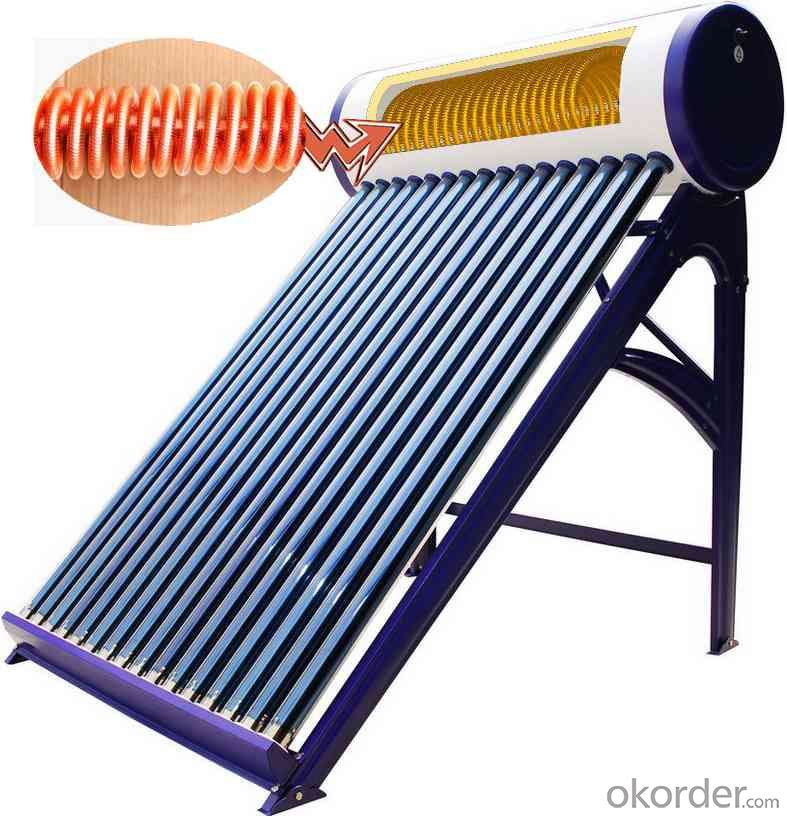
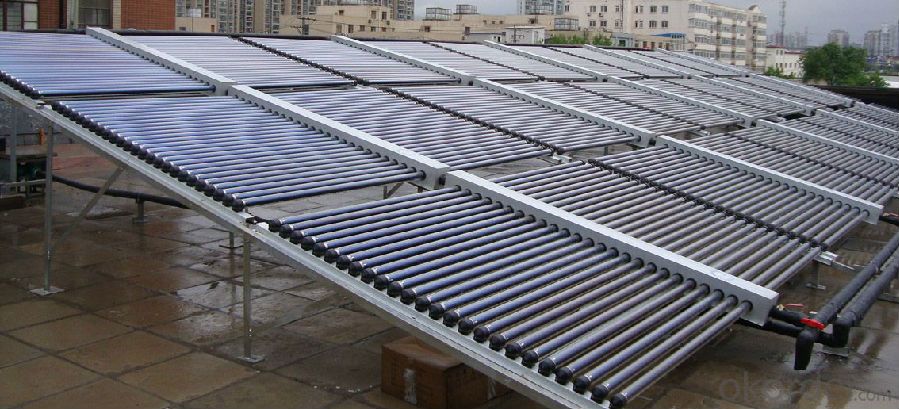
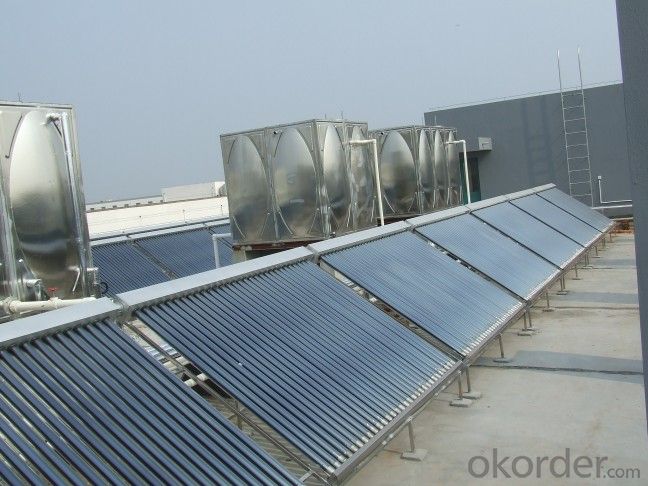
Our Services
1. OEM service
2. Warranty: 5 years
3. Considerable after sale service
Color steel Compact pressure Thermal solar heater
FAQ:
1. What’s the delivery time?
10 days after receiving deposit.
2. How long is the warranty?
5 years for whole system, 1 year for accessory
3. What’s your production capacity?
6000sets/month
4. What’s the MOQ?
1 set.
5. What’s your payment term?
Container: 30% T/T in advance for deposit, 70% T/T before shipment for fist order.
70% T/T after seeing copy of B/L from second order
Sample: 100% T/T in advance
Other choices: L/C at sight.
6. What certifications do you have?
CE, SOLAR KEYMARK, SRCC and etc.
- Q: What are the maintenance requirements for a solar water heater?
- The maintenance requirements for a solar water heater typically involve checking the system for leaks, cleaning the solar panels regularly, and inspecting the connections and valves for any signs of wear or damage. It is also important to ensure that the antifreeze solution, if used, is at the correct level and is replaced as recommended by the manufacturer. Additionally, periodic professional servicing may be required to ensure optimal performance and efficiency of the system.
- Q: What are the common warranty issues with a solar water heater?
- Common warranty issues with a solar water heater include defects in the collector, tank, or pump, malfunctioning sensors or controls, leaks in the plumbing system, and inadequate heat transfer. Other possible issues may include problems with the electrical components or damage caused by extreme weather conditions.
- Q: Can a solar water heater be used in areas with limited access to energy-saving technologies?
- Yes, a solar water heater can be used in areas with limited access to energy-saving technologies. Solar water heaters use sunlight as a renewable energy source to heat water, eliminating the need for traditional energy sources. This makes them a viable and sustainable option for areas with limited access to energy-saving technologies, as they are cost-effective and environmentally friendly.
- Q: Can a solar water heater be used in areas with high levels of electromagnetic interference?
- Certainly! Solar water heaters can be utilized in regions with significant electromagnetic interference. The main source of heat for these water heaters is solar energy, hence they are not dependent on or generate electromagnetic signals. Provided that the solar panels are adequately shielded and grounded, they will remain unaffected by any electromagnetic interference present in the vicinity. It is advisable to seek guidance from a skilled installer to guarantee correct installation and protection of the solar water heater system against any potential interference.
- Q: Solar water heaters do not want to do too hot water
- 2, in the winter can be set in the solar energy meter auxiliary heating temperature, reduce the temperature of the auxiliary heating.Solar water heater is a photothermal converter, different from the traditional natural use, such as drying, lighting.
- Q: When is the best solar water
- The best time for solar water supply, before the sun comes out in the morning in the summer, the sun fell in the evening after the vacuum tube cooling water is best; winter morning after the best temperature rise water. Summer solar water heater water not too late (after 9 a.m.), vacuum tube dry burning is very easy to aging, after a day of sun exposure, the temperature is very high, to the solar water heater vacuum tube cooling down to water, or endure the stimulation sometimes hot and sometimes cold especially the vacuum aging. The tube is very easy to burst pipes. Winter should be careful not to water at night, should try to raise the temperature in the morning or at noon when the temperature is high water, so you can avoid the temperature is too low icing solar energy up bad. Don't use solar water heater at noon when the sun is hot. The correct use of solar water heaters, solar water heaters to grasp the best time to ensure the normal operation of solar water heaters, thereby extending the life of solar energy.
- Q: Can a solar water heater be used in conjunction with a swimming pool?
- Yes, a solar water heater can be used in conjunction with a swimming pool. Solar water heaters are designed to capture and utilize the sun's energy to heat water, which can be used for various purposes including heating pools. By connecting a solar water heater system to a swimming pool, the water can be efficiently heated using renewable energy, reducing reliance on traditional heating methods and saving on energy costs.
- Q: How does a solar water heater impact the water temperature fluctuations?
- A solar water heater helps to minimize water temperature fluctuations by utilizing the sun's energy to heat the water consistently. This means that even during periods of low sunlight or colder weather, the solar water heater can still maintain a relatively stable water temperature, reducing the fluctuations that may occur with traditional water heating methods.
- Q: Can a solar water heater be used in areas with limited access to reliable weather forecasting or solar radiation data?
- Yes, a solar water heater can still be used in areas with limited access to reliable weather forecasting or solar radiation data. While accurate weather data and solar radiation information can help optimize the performance of a solar water heater, they are not essential for its basic operation. Solar water heaters primarily rely on sunlight to heat up water, and as long as there is sufficient sunlight available, the heater will still be able to function effectively. Even in areas with unpredictable weather patterns or limited sunshine, solar water heaters can still provide a significant amount of hot water. In such areas, it is advisable to install a properly sized solar water heater system to ensure that it can meet the water heating needs even during periods of lower solar radiation. Additionally, incorporating a backup heating source such as an electric or gas-powered water heater can provide hot water during extended cloudy periods or when solar radiation is insufficient. While having access to reliable weather forecasting or solar radiation data can certainly help in maximizing the efficiency of a solar water heater, it is not a prerequisite for its usage. With proper installation, sizing, and backup options, solar water heaters can still be a viable and sustainable solution for hot water production in areas with limited access to reliable weather data.
- Q: What is the impact of nearby trees or vegetation on the performance of a solar water heater?
- The impact of nearby trees or vegetation on the performance of a solar water heater can be significant. Trees or vegetation that cast shadows or block sunlight can reduce the amount of solar radiation reaching the solar panels of the water heater. This reduction in sunlight can result in a decrease in the efficiency and overall performance of the system. When shadows from nearby trees fall on the solar panels, the panels are unable to capture and convert as much sunlight into usable energy. This can lead to a decrease in the amount of heat generated by the solar water heater, thus reducing its ability to heat water effectively. In some cases, if the shading is severe, it may even prevent the system from functioning at its full capacity. Moreover, trees or vegetation that are too close to the solar water heater can also cause issues by blocking air circulation. Adequate airflow is crucial for the efficient operation of the system, as it helps dissipate heat and prevent overheating. When trees or vegetation obstruct the airflow around the solar panels or the water storage tank, it can lead to a buildup of heat and reduce the overall performance of the system. Additionally, leaves, pollen, and other debris from nearby trees or vegetation can accumulate on the surface of the solar panels. This accumulation can hinder the absorption of sunlight and reduce the efficiency of the water heater. Regular cleaning and maintenance may be required to keep the solar panels free from debris and ensure optimal performance. In summary, nearby trees or vegetation can have a negative impact on the performance of a solar water heater. Shading, obstruction of airflow, and accumulation of debris can all reduce the efficiency and effectiveness of the system. It is important to consider the placement and maintenance of the solar water heater in relation to surrounding vegetation to maximize its performance.
Send your message to us
Solar Water Heater for Pools with Copper Coil New Design
- Loading Port:
- China main port
- Payment Terms:
- TT OR LC
- Min Order Qty:
- 1 set
- Supply Capability:
- 6000 set/month
OKorder Service Pledge
OKorder Financial Service
Similar products
Hot products
Hot Searches
Related keywords
